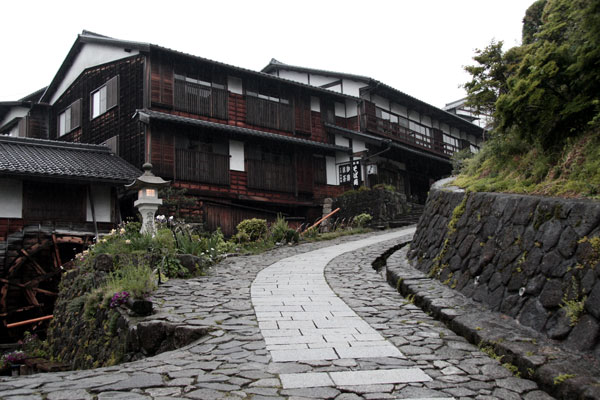
It was both a curse and a blessing -- the heavy downpour that plagued us through our hike also escorted us into a surprisingly deserted Magome-juku.
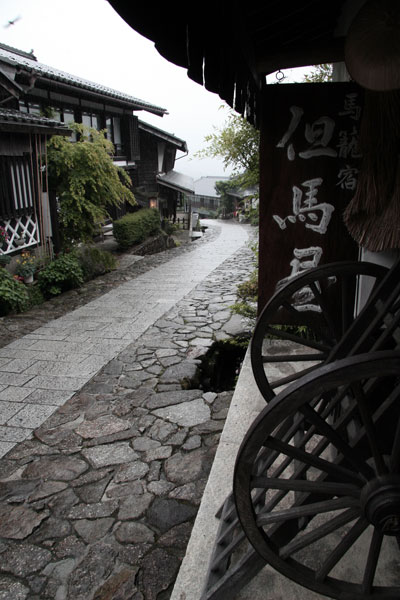
No crowds, no tour buses, just pure breath-taking townscape in the traditional contrast of white plastered walls upon dark wooden facades. Yes the weather was absolutely crappy, but the flipside was a rare glimpse of the town's rural tranquility with the effect of modern tourism. To entirely misquote Charles Dickens, it was the best and the worst of times to arrive at Magome.
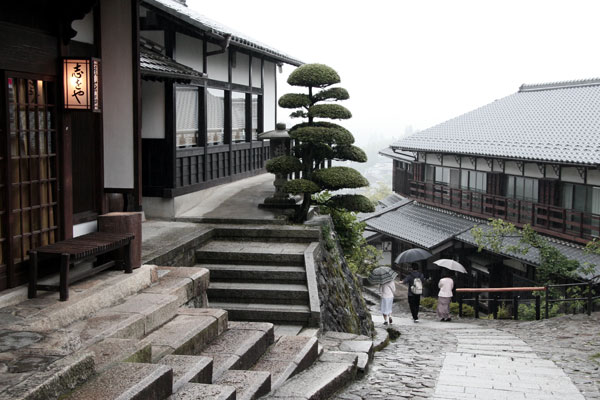
This was also a fitting place for the final evening of our self-guided tour of Central Japan, which had seen us through a pristine National Park, a pair of ancient hamlets and several old provincial capitals. At the end we arrived at this historical town along the old Nakasendo Highway, quiet enough to sit back and enjoy our last evening in Japan but close enough to Nagoya to not miss our flight the next day.
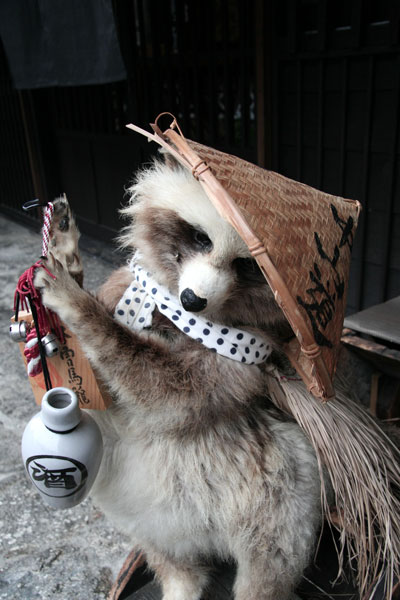
Magome-juku was the third and southern-most post-town we visited in the ancient Kiso Valley, famous for its excellent preservation of feudal-era traveler stops along its stretch of the path that connected the Imperial Court in Kyoto to the Tokugawa Shogunate's power in present-day Tokyo. Originally designated as one of the 69 Shukuba (ie. rest area; hence the "-juku" suffix) along this Nakasendo road, the town of Magome narrowly escaped modernization along with Tsumago due to the same reason -- the Chuo Honsen railroad never got very close to the town. Today the nearest train stations of Sakashita and Nakatsugawa are a 20 minute bus ride away, which still works well to deter some of the lazier tourists.
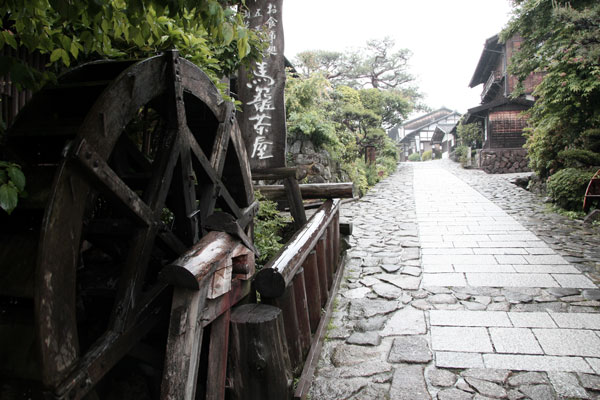
Compared to its neighbor Tsumago in the Nagano Prefecture, Magome and the Gifu Prefecture have directed the tourism revenue into maintaining a better organized, tourist-friendly town that also appears somewhat deliberately staged. The main street that runs the entire length of the town has been recently repaved with perfectly-cut granite stones, and virtually all of the old peasant townhouses have been reborn as souvenir shops or restaurants. Or at least that's the fate of the street-facing front of the houses ... the backside of the houses remain private residences, mostly to the modern descendants of original families who had lived in this town for centuries.
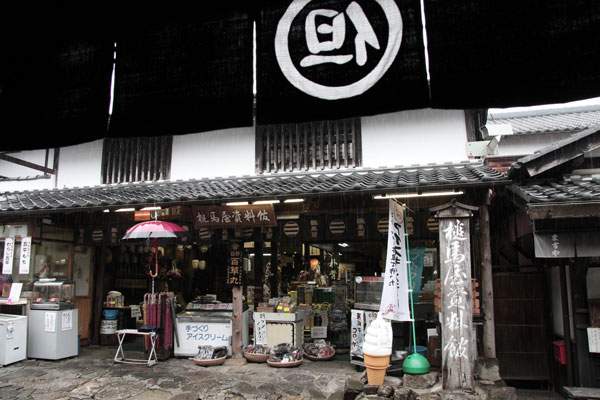
Rebuilt after successive fires at the turn of the 20th Century and elaborately manicured into the ideal Japanese feudal townscape over the recent decades, the town of Magome has gained somewhat of a reputation as a tourist trap. On any given day coach-loads of domestic and foreign tourists would be dropped off at the large parking lot at the top of the town, given a hour to do their sightseeing and obligatory souvenir shopping along the picture-perfect main street, and picked up again at the bottom of the town.
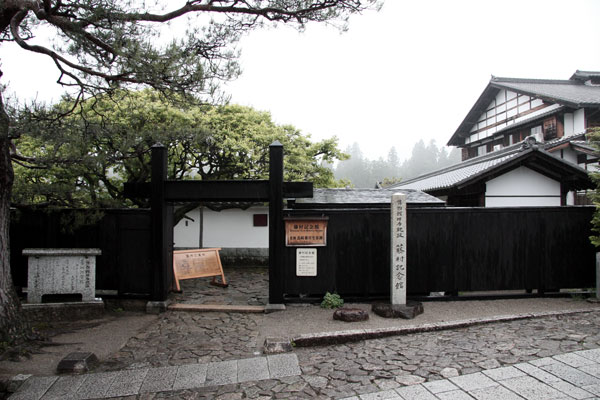
But not on this day. By 15:00 the monsoon rain had chased off the day-tripping tourists and uniformed students on their annual excursions, leaving behind just a ghostly shell of the normally bustling town. Occasionally an odd remaining tourist would pass by, huddling beneath an under-sized umbrella and hurrying off to the next destination. It's funny that no matter how successful the town may have been in adapting to the demands of 21st Century tourism, the weather still functions as the great equalizer to restore everything back to their old ways.
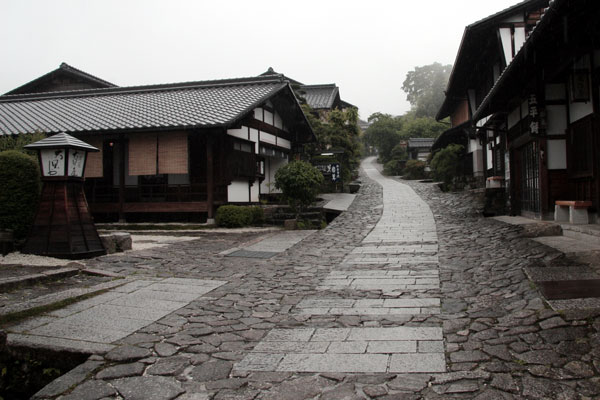
A day-tripper could probably rush through all the famous landmarks in a matter of an hour. The town's main entrance at the uphill end features a re-creation of the old Kosatsuba, the official bulletin board for the feudal government's old edicts and laws. The town's major museum, an elegant reconstruction of the birthplace of famous novelist Shimazaki Toson, is located near the halfway point of the town. And towards the bottom, the main street takes a sharp 90-degree turn to the left as a defensive feature to confuse any would-be attackers and bandits. After that, a time-crunched passer-by could reasonably claim to have toured all of Magome-juku.
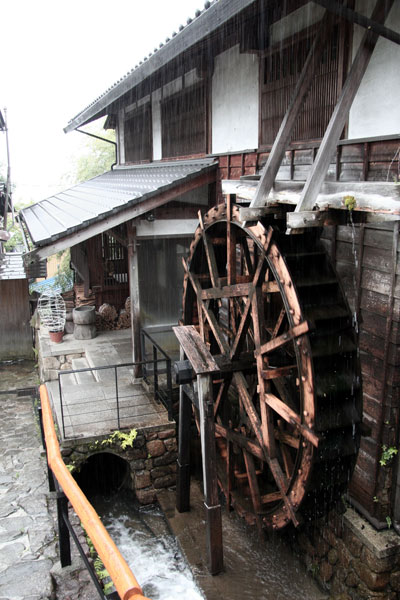
But to the town's credit, its beauty and culture run much deeper beyond the few advertised attractions. On one side of the steeply inclined main street stood two giant water wheels, one belonging to the Minshuku Magomechaya, and a second one belonging to an uninhabited, nameless hut that seemed to have no owner but the town itself. In this torrential downpour the wheel howled furiously in a spinning frenzy, driven by the rainwater channeled down from the mountain and through the length of the town. At first glance it would seem the most unlikely place for a peaceful refuge from the rain for wet and weary travelers.
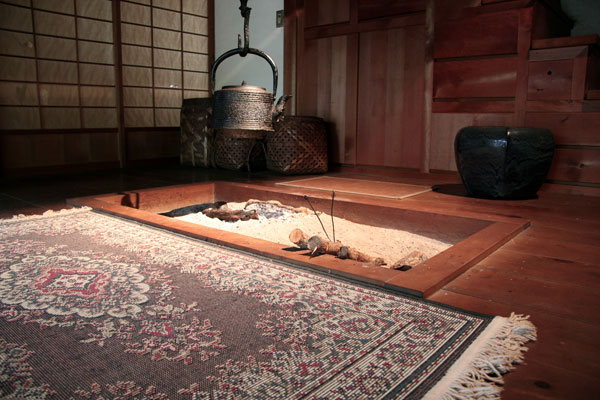
What a pleasant surprise awaited curious travelers inside -- a clean, warm and cozy rest-stop available to anyone free-of-charge, complete with an Irori fire pit that was still burning when we arrived around 17:00. The rugs were clean enough to lie down upon, and the decor was entirely authentic with a traditional step-ladder cabinet ... you know what I'm getting at ... although I wouldn't recommend it, if you're a single backpacker who happen to be "passing through" Magome in the warmer months without a guesthouse reservation ...
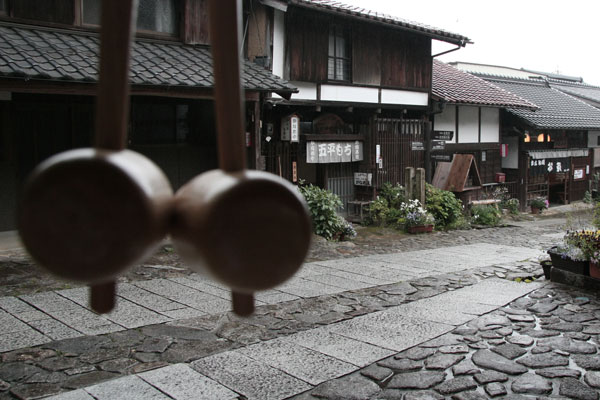
Well, that may be of more interest to the frugal backpackers. For the more affluent tourists the town's myriad of souvenir stores may be a bigger attraction, even though much of the selection may seem familiar at first glance. But looking a little closer you'll discover remnants of the region's indigenous culture that you simply won't see anywhere else in Japan. At one shop we even saw an sign that stated "Hachi-no-ko / Inago Arimasu" -- or "Bee Larvae and Grasshoppers Available" -- right next to the Hello Kitty and Doraemon merchandises. Please see the
previous article on Tsumago-juku if you've got the appetite for a picture of deep fried grasshoppers in a sweet soy-sauce glaze.
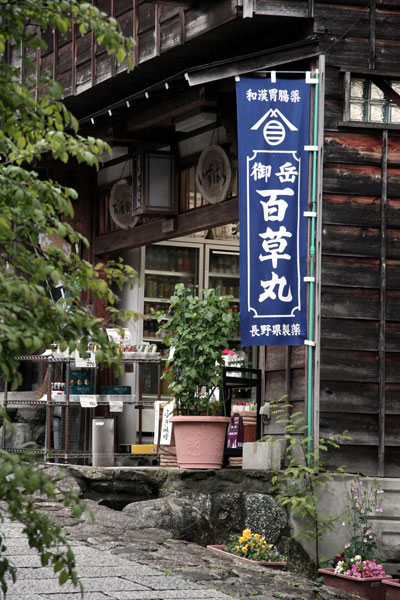
In terms of popularity among Japanese tourists, one of the big sellers at the souvenir stores is this traditional intestinal medicine known as Ontake Hyakuso-gan. This herbal remedy is said to have been invented by followers of an animistic cult worshiping the snow-capped peak of the nearby Ontake Mountain, and became a popular treatment for upset stomachs and diarrhea for these pilgrims. Today you can purchase it in the form of bottled pills for a few hundred yens at most stores in town. You can find more information on the
manufacturer's English website if you're curious.
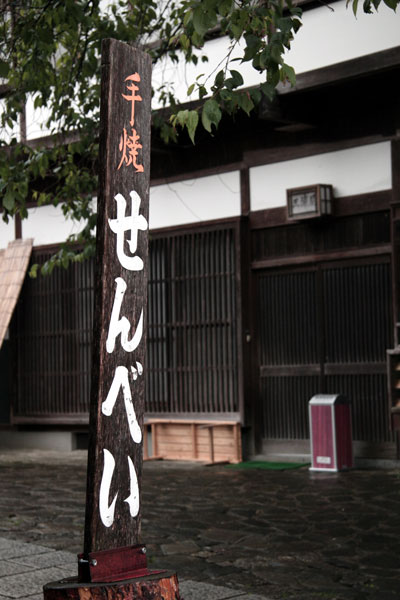
Then there are the ubiquitous street snacks such as the "Hand-roasted Senbei" crackers advertised here. If you're hungry for a quick and filling bite, I highly recommend a local form of grilled rice-cake-on-a-stick known as Gohei-mochi. Roasted sparrows (Suzume) are supposed to be another popular snack in this region, but sadly we didn't run into any sparrow vendors on this rainy day. And besides, it was getting close to dinner time at our Minshuku guesthouse anyway.

We wouldn't miss the magic of the evening stroll, even if it meant walking the slippery incline of the main street in this unrelenting rain. Much like Tsumago-juku on the previous night, the town of Magome-juku slipped back a couple hundred years into the feudal ages again, illuminated by nothing but the hanging lanterns and the dim light seeping through the dark wooden lattices of the Machiya houses. By far this was my favorite experience at Magome. There was the inconvenience of having to carry a traditional wax-paper umbrella provided by our guesthouse, but that's also part of the romance of these old-fashioned small towns, depending on how you choose to look at it.
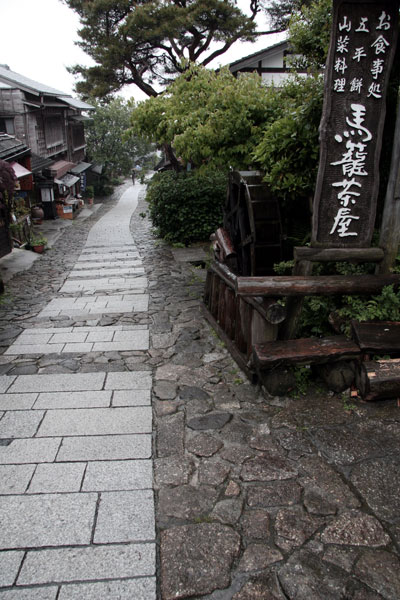
So how much time should an independent traveler allot for visiting Magome-juku? A couple hours is clearly not enough to fully appreciate the town, and besides this kind of old-town scenery is typically best at sunset or early morning. I would suggest a 2-day trip combined with Tsumago-juku, and the night can be spent at either town. Having stayed overnight at both towns, I felt that the larger and more commercialized Magome was better for walking and souvenir hunting, while the smaller and older Tsumago was more suitable for unobstructed photo-ops in the early morning. I happened to have taken more of my favorite photos at Tsumago, but I guess that's just my gut feeling.
As I mentioned we stayed at a traditional Minshuku, in fact the most famous Minshuku in this small town ...
Hotel Review: TAJIMAYA (Magome-juku)
Address: Gifu-ken Nakatsugawa-shi Magome 4266
Price: 8400 yen per person including dinner and breakfast
Website/Map: http://www.takenet.or.jp/~marutaji/How To Book: Through the official website
Directions: Right at the centre of town ... you can't miss the wooden cart and the waving Tanuki.
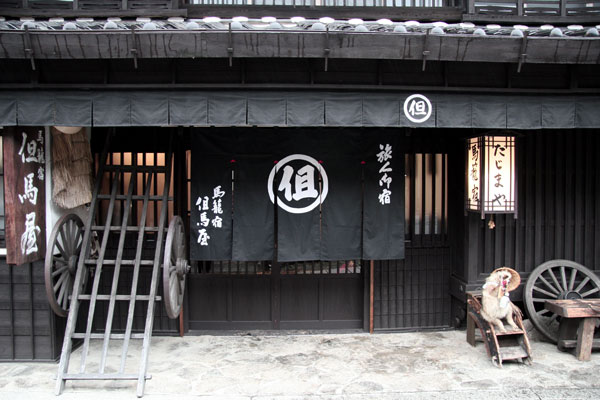
Some may call it a deliberate showcase of all things nostalgically Japanese -- sun-faded Noren curtains and dark wooden lattices, dim lanterns and broken farmhouse equipments, and even a little Kawaii mascot (actually a stuffed Tanuki) to grab the attention of passing tourists. But to us, this was simply one of the most aesthetically striking Minshuku guesthouses we've stayed in.
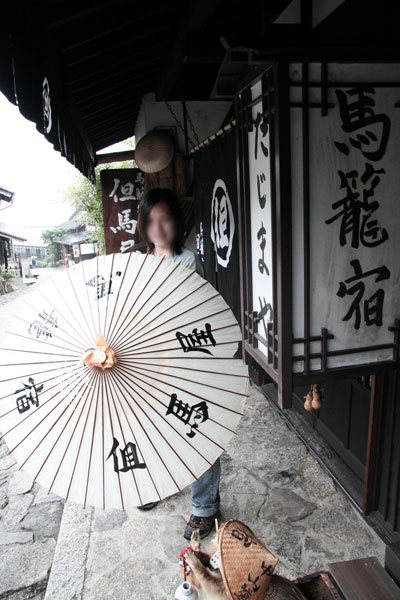
Now this isn't just an ordinary Minshuku -- for more than 200 years Tajimaya has been a local fixture, and is currently the oldest accommodation establishment in town. In fact the manager, a spectacled middle-aged man who can speak reasonable English, is the
8th Generation descendant in a long line of inn-keepers. If Japanese culture and tradition is of any consideration to you in your choice of accommodation, I don't think you can find a more distinguished place to stay within Magome.

That's not to say that the building is old and creaky -- it just means that you'll encounter certain antique features you won't find in most Japanese households, the most obvious of which is the Irori firepit in the greeting room. In the evening the manager would bring all the guests around the fire and teach the region's indigenous folk dance known as Kiso-odori for free. Frankly I think he's really enjoying it.
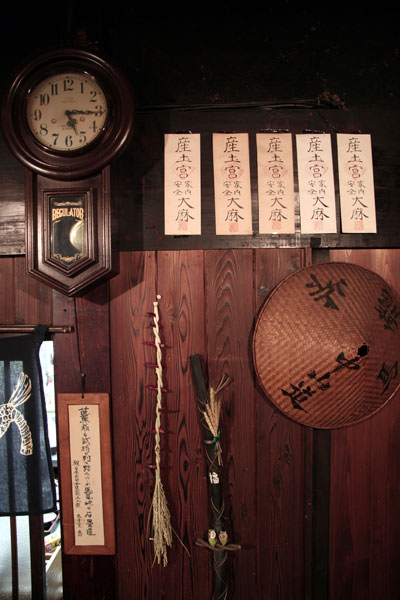
Fire has been Magome-juku's nemesis throughout its long and unfortunate history, and the town's interconnected rows of Machiya houses were burned to the ground many times. As a result the current building of Tajimaya is only a hundred years young, with much of the interior decor emulating an atmosphere of the late-Meiji / early-Taisho period.
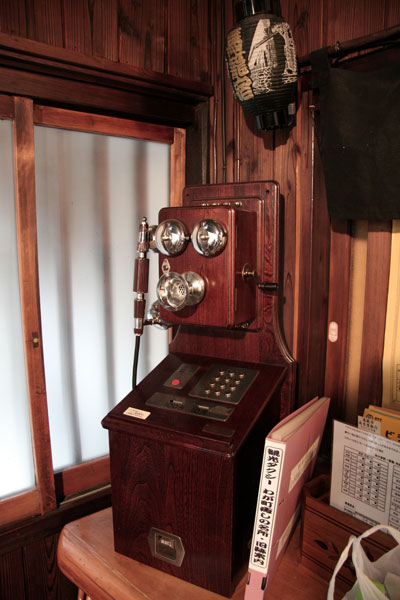
I think emulate is the right word here, for if you look closely at the telephone, you'll see the touch-tone buttons and insertion slots for your 100-yen coins. Oh well ... at least they're well-organized enough to provide contact numbers of the local taxi company and information sheets for the region's tourist attractions.
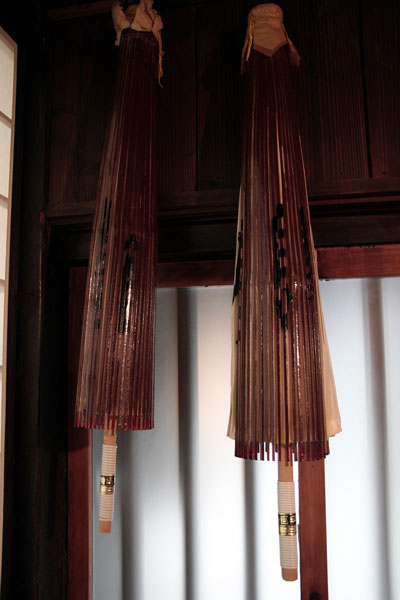
We certainly didn't miss the chance to borrow one of the Minshuku's own wax-paper umbrellas to play in the rain. It turned out to be surprisingly effective for shielding my camera from getting wet.

The guesthouse was booked to its full capacity on this day with several 3- and 4-person groups, but quite surprisingly the two of us were assigned the best room in the house -- actually two connected chambers of 6-Tatami-mats each, with windows overlooking the historic Nakasendo road. This probably had something to do with the fact that we made our booking very early on (3 months in advance), so here's a tip if you plan on booking this Minshuku.
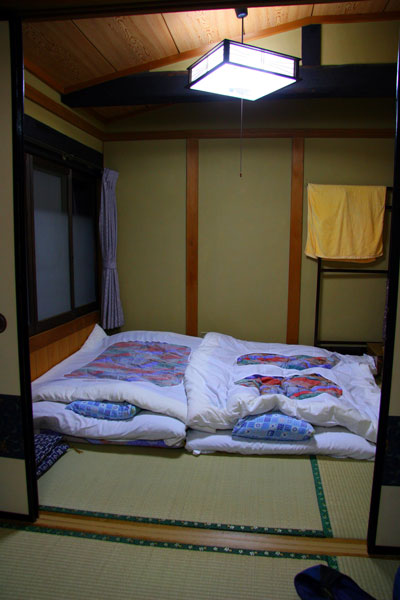
With a total of 12 Tatami mats we could afford the luxury of setting up our futons in one chamber and unpack at the other. As usual the room came with air-conditioning, a low table with a tea set, a small TV, towels and Yukata robes for lounging around the guesthouse. I think I even ventured outside wearing the Yukata and the house's wooden clogs, though the neighbors probably didn't appreciate it as much as I did.
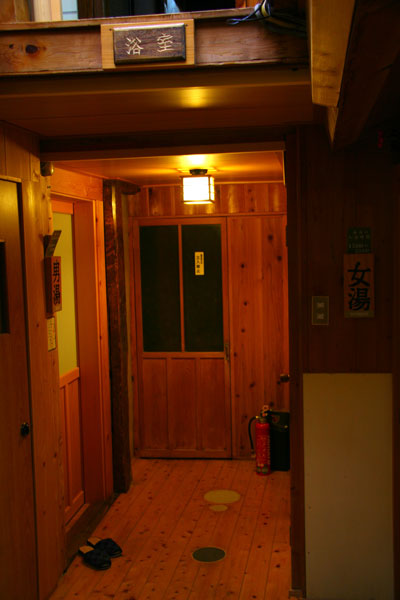
As in most traditional Minshukus, bathing is communal with separate male and female baths. I can't speak for the female side, but on the male side there wasn't even a lock on the door -- you just walk in, wash and clean yourself at the showers at the side of the bathroom, then take your relaxing dip in a bathtub large enough for two, with or without other guests being present. Definitely DON'T MISS the wooden bathtub made of local Hinoki (Japanese Cypress) wood -- the moment of taking off the bathtub's lid and filling the entire room with the woody fragrance of the Hinoki was quite an experience. Plus, at upwards of 400,000 yen (CAD$4000) it was quite possibly the most expensive bathtub I've ever used.
For the reasonable price of 8400 yen, the comfort level and features of the guesthouse were definitely recommendable ... so long as you can live without a private bathroom for a night. Next you're probably wondering about the quality of the two meals that came at this price.

The dinner was actually better than what we would expect from an average family-run Minshuku -- nothing incredibly amazing of course -- but it was an exhaustive 11-course meal with local ingredients reflecting the region's culinary character. And given the guesthouse's recent popularity with international tourists, the meal featured a thoughtfully toned-down selection from the Kiso Valley's local cuisines -- that is, without the deep fried grasshoppers or bee larvae.
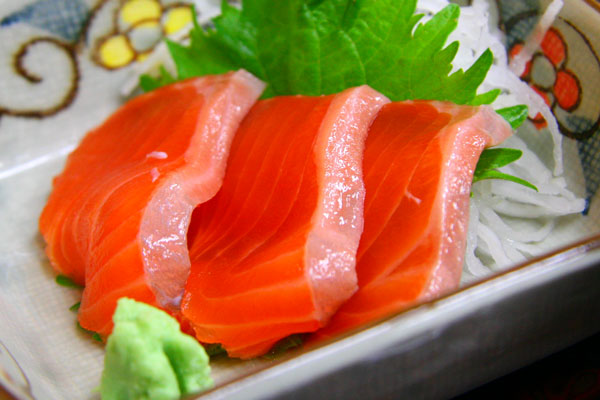
No horse sashimi for a change -- instead it was another local ingredient, the highly prized, nationally branded Shinshu Salmon. Despite the bright reddish flesh it's technically not a salmon, but a cross between the rainbow trout and the brown trout. The taste was somewhat comparable to farmed Atlantic salmon in Canada -- delicately textured, quite fatty, and sweet without any hint of fishiness.
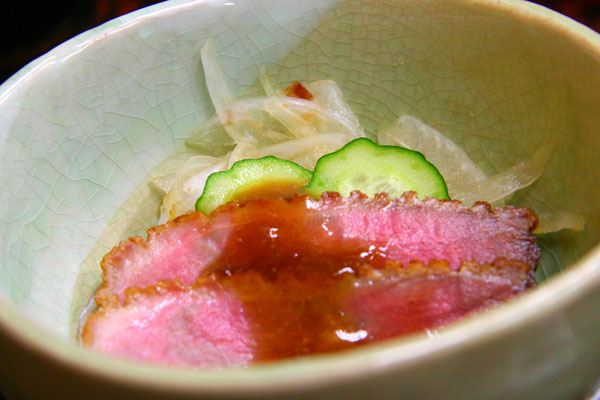
Kamo-niku no Rosu Yaki. A non-traditional dish using a traditional ingredient, this grilled duck breast was presented on a bed of daikon with a soy- and yuzu-based dressing. Very soft and tender, but not as flavorous as I hoped and not quite my favorite dish.
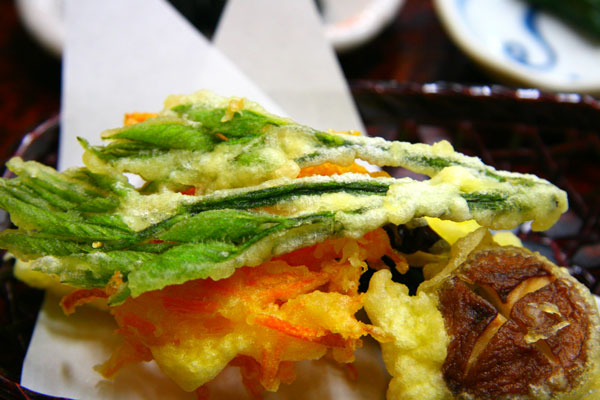
For about the sixth time on this trip I was treated to one of my favorite rural Japanese delicacies ... I was falling love with the distinct aroma of wild-harvested Yamaudo leaves! The excellent quality of the tempura came as a pleasant surprise, especially considering the popularity of this Minshuku on this evening ... you know what I mean.

Simmered rainbow trout in a sweet soy sauce, humorously paired with ... fried potato wedges!? I must have had grilled freshwater fish about five times this week in our trip across Central Japan, so this alternate presentation in a delicious sweet sauce (Kanro-ni) was a much appreciated change.
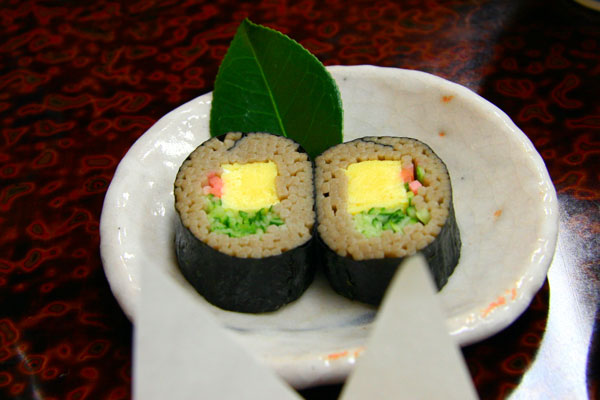
What's a Central Japanese meal without a little hand-made Soba noodles? I've never had Soba-zushi before, and was quite surprised that the noodles were seasoned with vinegar like ordinary sushi.
The overall quality of the dinner was above average for a Minshuku, and even approaching Ryokan quality. On the other hand you could also argue that 8400 yen a night was also approaching the price of cheaper Ryokans. But when the only Ryokan in town (Ryokan Iwatake) charges another 2100 yen more for a marginally better room, I felt that Minshuku Tajimaya was a decent deal considering the lack of more stellar choices.
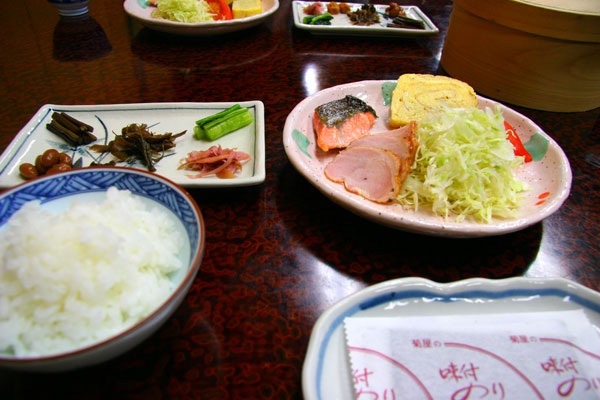
After an unremarkable but full breakfast the next morning, the manager drove us to the bus-stop at the bottom of the town where we caught our 08:10 bus to the Nakatsugawa train station. The rain finally stopped before we our planned arrival at Nagoya at 10:00 ... perhaps an auspicious start to our final day in Central Japan?
TRANSPORTATIONThe easiest way to reach Magome is by an hourly bus from the Nakatsugawa train station, the largest transportation hub in the Kiso Valley. If you're starting out from Tokyo or Osaka, it would be quickest to take the Shinkansen to Nagoya, then transfer to an Express train in the direction of Shiojiri. The train ride from Nagoya should take about an hour.
Once you get to Nakatsugawa, take the local bus operated by Kita-Ena Bus with "Magome" as the final destination. See the official website below for the latest schedule -- just follow the English words "Nakatsugawa" and "Magome" and ignore the Japanese:
http://www.rosenzu.com/kitaena/magome.htmlThe other useful bus route is the infrequent
Magome - Tsumago bus, the most convenient way to travel between the two neighboring towns if you're not planning to do the hike. Please see the Transportation section in the
Tsumago article for timetable details.
 Ugallery.com is an online store selling original art from top collegiate artists. Ugallery realizes most people can’t afford to pay tens of thousands of dollars for original artwork, so they've created a curated gallery with prices from $20 to $5,000. You can search for art by genre, color, size, medium, and price, and try out your favorite piece on the Virtual Wall to see how it will look before you buy it.
Ugallery.com is an online store selling original art from top collegiate artists. Ugallery realizes most people can’t afford to pay tens of thousands of dollars for original artwork, so they've created a curated gallery with prices from $20 to $5,000. You can search for art by genre, color, size, medium, and price, and try out your favorite piece on the Virtual Wall to see how it will look before you buy it. (Images from Ugallery.com artists)
(Images from Ugallery.com artists)





























































